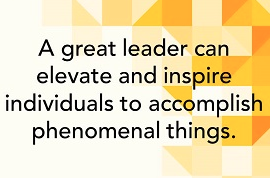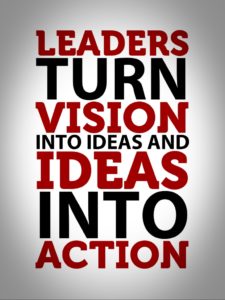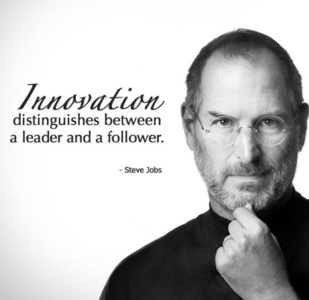6 Essential Leadership Behaviors to Inspire Teams & Drive Results
 One of the greatest challenges to identifying high potential leaders is to look beyond collective job experience and gain an understanding of leadership behaviors that inspire teams and shape organizations. Truly great leaders are those with a high level of personal awareness and emotional intelligence. Too often the resume outweighs the importance of interpersonal behaviors resulting in low morale and poor performance.
One of the greatest challenges to identifying high potential leaders is to look beyond collective job experience and gain an understanding of leadership behaviors that inspire teams and shape organizations. Truly great leaders are those with a high level of personal awareness and emotional intelligence. Too often the resume outweighs the importance of interpersonal behaviors resulting in low morale and poor performance.
There are many resources available to measure leadership performance and investing in a quality assessment can uncover leadership traits that are critical to organizational success. We have had tremendous success with the newest addition to the *PXT Select suite of assessments – the Leadership Report. This report provides an in depth look at how an individual’s skills and behaviors may contribute to leadership potential:
Briefly, the Leadership Report outlines the following for a comprehensive view of leadership measured against an ideal leadership model:
1) Results Summary: Results are presented for the individual’s Thinking Style, Behavioral Traits, and Interests.
2) Leadership Capabilities: Six essential leadership capabilities are illustrated, along with the traits, scales, and interests that drive each.
3) Skills: The individual’s characteristics, strengths, and challenges are interpreted as they relate to each Leadership Skill.
4) Leadership Potential Actionable Questions: Insightful questions drive discussion and evaluation of leadership potential in specific workplace scenarios.
Leadership Skills
Leading a team or an organization is a complex undertaking that often demands a diverse set of capabilities. These six leadership skills are essential to the success of organizational leaders.
 Creating a Vision:
Creating a Vision:
Leaders who excel at creating a vision vividly imagine new ideas, directions, and innovations for the future. They think big and redefine the boundaries of what’s possible for their team, their organization, and their industry. Measures for Creating a Vision are based on:
1) Decisiveness – The balance of speed and caution when making decisions. Deliberate vs Bold
2) Judgment – Basis for forming opinions and making decisions. Intuitive vs Factual
3) Creative – Suggests a preference for imaginative and innovative thinking.
Developing Strategies:
Developing strategies is about transforming goals and ideas into action plans that are both innovative and achievable. To do this, leaders must understand their organizations’ unique resources and challenges, and, when necessary, use this knowledge to be agents of change. Measures for developing strategies are based on
1) Conformity – Attitude on policies and supervision. Optimally, there is a balance between strong-willed and compliance when developing strategies.
2) Judgment – Basis for forming opinions and making decisions. Intuitive vs Factual
 Ensuring Results:
Ensuring Results:
Leaders who ensure results implement organizational priorities and make sure they get carried out accurately and efficiently. They set the pace of work and establish expectations of quality throughout their teams. Measures for ensuring results are based on:
1) Pace – Overall rate of task completion with balance between a steady pace and urgency.
2) Assertiveness – Expression of opinions and need for control. Unassuming vs Forceful
3) Decisiveness- Use of speed & caution to make decisions. Is the potential leader more deliberate or bold when making decision?
 Inspiring People:
Inspiring People:
Creating clarity and unity around ideas is the core of inspiring people. Effective leaders communicate with contagious enthusiasm for new endeavors, and they convince peers, superiors, and subordinates of the merits of their cause or line of reasoning. Measures for ensuring results are based on:
1) Sociability – Desire for interaction with others. Is the potential leader more reserved or outgoing?
2) Outlook – Anticipation of outcomes. Is there a healthy balance between skepticism and trust?
3) Enterprising- Suggests the enjoyment of leadership, presenting ideas, and persuading others.
Being Approachable
By being approachable, leaders empower their team members to come forward to get clarification, address concerns, and present ideas. They are open to feedback and build morale by making others feel heard. Being approachable is based on:
1) Assertiveness – Expression of opinions and need for control. Is the potential leaders behavior more towards unassuming or forceful?
2) Sociability – What is the potential leaders preference for interaction with others? Reserved or Outgoing
3) Accommodation- Inclination to tend to others’ needs and ideas. Balance between firm/unwavering and agreeable.
 Mentoring Others
Mentoring Others
Effective leaders know that mentoring others is an investment in the future of the organization. They help team members develop the skills, connections, and confidence to do their jobs more effectively, growing the next generation of leaders in the process. Mentoring others is based on:
1) Outlook – Anticipation of outcomes and motives. Is the potential leaders behavior more towards skepticism or trusting?
2) Accommodation – Inclination to tend to others’ needs and ideas.
Firmly fixed or generally agreeable?
3) People service- Suggests the enjoyment of collaboration, compromise, and helping others.
Just as there is no one-size-fits-all description of a perfect leader, there is no set of results or end of a behavioral continuum that is inherently better than any other. Consider your company culture, the specific leadership roles and the needs of your organization and your industry.
Stay tuned for our next Leadership series blog post: ’12 Critical Questions to Assess Leadership Behaviors’
PXT Select is a registered trademark of John Wiley & Sons, Inc.
